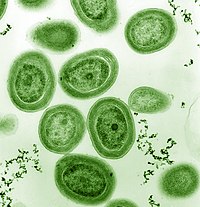
Photo from wikipedia
Adriatic, the northernmost part of the Mediterranean Sea, due its oligotrophy, topography, and hydrology dynamics, and complex circulation patterns, was suggested as an important study site for rapid climatology impacts.… Click to show full abstract
Adriatic, the northernmost part of the Mediterranean Sea, due its oligotrophy, topography, and hydrology dynamics, and complex circulation patterns, was suggested as an important study site for rapid climatology impacts. Its southern part is mainly oligotrophic and dominated by picophytoplankton, with cyanobacteria as main representatives. Diversity and distribution patterns of different Prochlorococcus ecotypes were investigated by molecular tools and flow cytometry during the winter convection event in the southern Adriatic (BIOTA winter cruise; February/March 2015). Phylogenetic diversity based on clone libraries of the 16S-23S ribosomal DNA ITS region, as well as flow cytometry (histograms of red fluorescence), indicated presence of 2 different Prochlorococcus in the Adriatic. HLI, as a typical clade for Mediterranean Sea, was likewise found to be dominant Prochlorococcus in the Adriatic, followed by less abundant LLI clade. In addition, Prochlorococcus were found to co-occur with diverse Synechococcus population (53% and 47% of obtained ITS sequences, respectively). Different Prochlorococcus ecotypes had similar patterns of vertical distribution, predominantly occupying upper 100m depth layer, but their distribution was clearly affected by the heterogeneity of hydrological conditions, nitrogen concentration and temperature along vertical and horizontal sampling points. Different studies pointed out that, as a consequence of climate changes, serious alteration of biological and ecological patterns are already taking place Therefore, understanding of the distribution and abundance of picophytoplankton in Adriatic, being still limited, is much needed baseline for predicting possible biogeochemical impact of future environmental changes.
Journal Title: Marine genomics
Year Published: 2017
Link to full text (if available)
Share on Social Media: Sign Up to like & get
recommendations!